Fuel injection for classics
Discussion
I'm toying with the idea of converting my Ginetta G15 (fast road spec. 998cc. Imp engine, currently on twin Webers with an R17 cam) to fuel injection.
Does anyone have any experience of THESE GUYS?
They're not too far from me; time is money and the idea of a full kit using DCOE-compatible throttle bodies appeals, rather than messing about with the 'budget' route of adapting bike throttle bodies and piecing a system together myself, but the concept of an ECU that effectively maps itself, on the road, using the readings from the lambda sensor, seems too good and too simple to be true?
Anyone tried this system on their classic? Did it work?
Does anyone have any experience of THESE GUYS?
They're not too far from me; time is money and the idea of a full kit using DCOE-compatible throttle bodies appeals, rather than messing about with the 'budget' route of adapting bike throttle bodies and piecing a system together myself, but the concept of an ECU that effectively maps itself, on the road, using the readings from the lambda sensor, seems too good and too simple to be true?
Anyone tried this system on their classic? Did it work?
Most aftermarket ECUs support 'open loop' self tuning - provided you have a wide band lambda sensor (basically give an accurate CO2 reading over a wide range, rather than cheaper narrow band ones that just give accurate measure around the 14.7:1 stoichiometric ratio and "rich" or "lean" outside that).
From the ECUs point of view it's not that hard. Whenever conditions are fixed (engine load/RPM) the lambda reading should be 14.7:1. If it isn't add/remove fuel until it is, then update the map real time with the new value for that load/RPM site.
That's just the fueling side though and I don't know if ECUs can also self learn ignition timing, assuming you swap away from the dizzy at the same time.
From the ECUs point of view it's not that hard. Whenever conditions are fixed (engine load/RPM) the lambda reading should be 14.7:1. If it isn't add/remove fuel until it is, then update the map real time with the new value for that load/RPM site.
That's just the fueling side though and I don't know if ECUs can also self learn ignition timing, assuming you swap away from the dizzy at the same time.
Equus said:
Does anyone have any experience of THESE GUYS?
They're not too far from me; time is money and the idea of a full kit using DCOE-compatible throttle bodies appeals, rather than messing about with the 'budget' route of adapting bike throttle bodies and piecing a system together myself, but the concept of an ECU that effectively maps itself, on the road, using the readings from the lambda sensor, seems too good and too simple to be true?
Anyone tried this system on their classic? Did it work?
Never heard of them or their product, interesting reading so thanks for sharing.They're not too far from me; time is money and the idea of a full kit using DCOE-compatible throttle bodies appeals, rather than messing about with the 'budget' route of adapting bike throttle bodies and piecing a system together myself, but the concept of an ECU that effectively maps itself, on the road, using the readings from the lambda sensor, seems too good and too simple to be true?
Anyone tried this system on their classic? Did it work?
My old man stuck Jenvery's 'Weber carb' throttlebody setup on a fast-road Alfa twinspark lump he built for a 105-series car, it worked well and was relatively painless to install, although not the cheapest.
Hi Equus
The Gilbern Invader Mark 3 with a Ford Essex V6 that I bought back in February came with a full Emerald ECU, Jenvey throttle bodies (3xDCNF twin chokes) and a lot of relays, cables, coil pack, aux air valve, inlet temp reader, trigger wheel etc etc
All seems to work (now) but to a 70 year old used to carbs and distributor rather complex and when it was all installed and set up by the (late, RIP Tony) previous owner I was somewhat in the dark at first but the accompanying book by Dave Walker helped, although it was already set up by Tony and then checked by Dave.
Trouble is, IF it all goes wrong at the side of the road, I've no idea how to fix it whereas carbs and dizzy should be OK
There's an Imp, running carbs off a Honda (IIRC) which apparently runs nicely, it lives up in Scotland still I think, you could probably catch him on the FB page. Used to be Paul Conroy but he sold it a year or so ago.
Just realised, I put the before not after pic of the Essex V6
After pic now shown
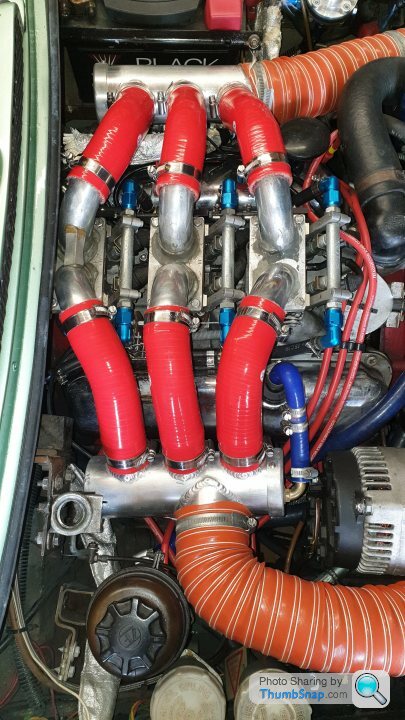
This Imp, sorry no pic of engine
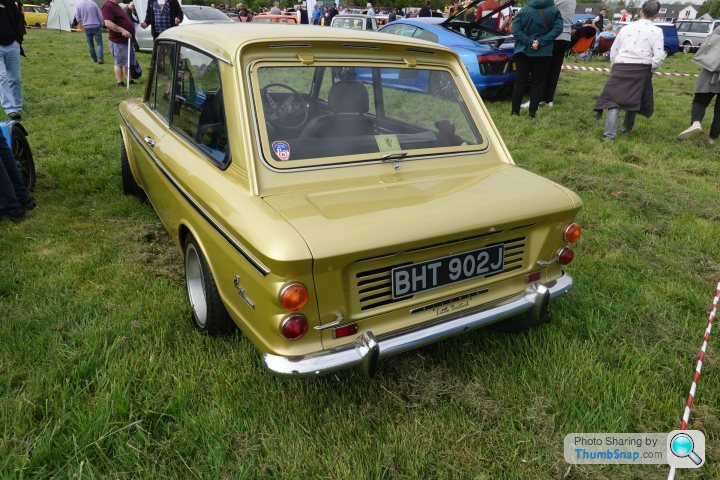
The Gilbern Invader Mark 3 with a Ford Essex V6 that I bought back in February came with a full Emerald ECU, Jenvey throttle bodies (3xDCNF twin chokes) and a lot of relays, cables, coil pack, aux air valve, inlet temp reader, trigger wheel etc etc
All seems to work (now) but to a 70 year old used to carbs and distributor rather complex and when it was all installed and set up by the (late, RIP Tony) previous owner I was somewhat in the dark at first but the accompanying book by Dave Walker helped, although it was already set up by Tony and then checked by Dave.
Trouble is, IF it all goes wrong at the side of the road, I've no idea how to fix it whereas carbs and dizzy should be OK
There's an Imp, running carbs off a Honda (IIRC) which apparently runs nicely, it lives up in Scotland still I think, you could probably catch him on the FB page. Used to be Paul Conroy but he sold it a year or so ago.
Just realised, I put the before not after pic of the Essex V6
After pic now shown

This Imp, sorry no pic of engine

Edited by Skyedriver on Thursday 28th September 19:07
Edited by Skyedriver on Thursday 28th September 19:09
I have done 3 Jenvey/ Emerald ECUs on XKs. They have all been excellent.
I recommend Emerald in Watton, as they will give you support if you need it.
They also have qualified technicians, Dave Walker and a rolling road.
They also are good at extracting parts from Jenvey, who seem to not want to pick up the phone.
The base maps they supplied with the ECU were spot on.
The Emerald also seems indestructible, the wiring quite simple.
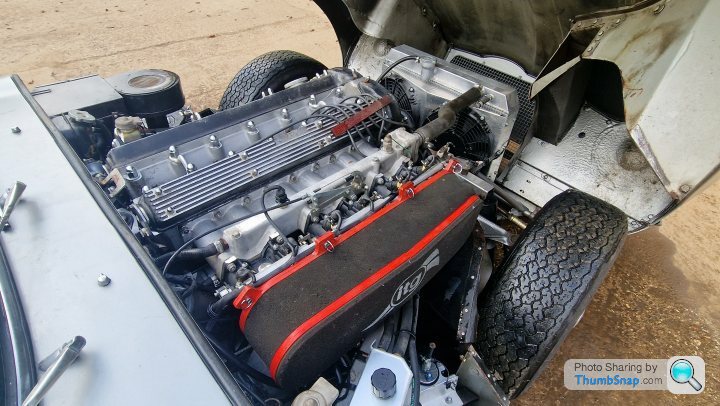
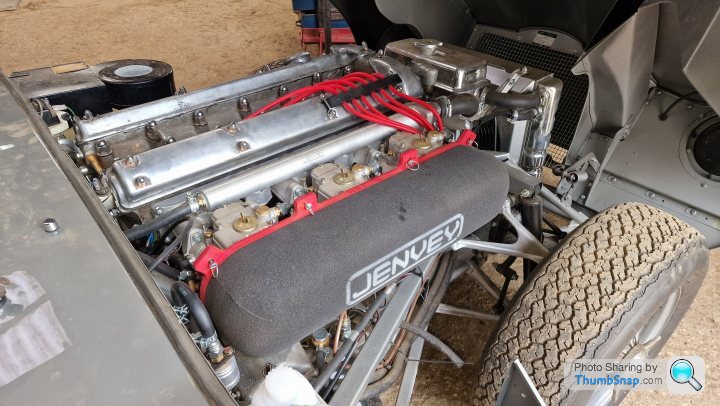
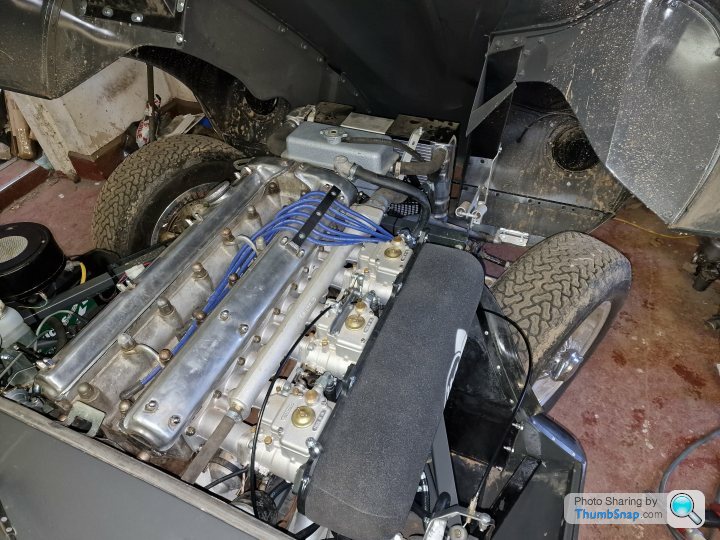
I recommend Emerald in Watton, as they will give you support if you need it.
They also have qualified technicians, Dave Walker and a rolling road.
They also are good at extracting parts from Jenvey, who seem to not want to pick up the phone.
The base maps they supplied with the ECU were spot on.
The Emerald also seems indestructible, the wiring quite simple.



Edited by politeperson on Thursday 28th September 17:06
I went part way with a lotus twin cam - 3d mappable ignition, tps, trigger wheel, wasted spark and it made a massive improvement to starting drive ability and general road manners especially after a full rolling road set up courtesy of Peter burgess of this manor. I would say it got me 75% if the advantages of full fi. I worked out to do the thing properly with Jenveys, omex, lambda etc was going to cost the best part of £3.5k so I stuck with ignition only. The full system does still appeal though as carbs are indeed a box full of compromises (as I think Dave Andrews observed)
Thanks for the comments so far - all useful and promising stuff!
On specific points:
Apart from liking the idea of a 'plug and play' kit because I'm fundamentally lazy, the fact that I'm running twin Webers already seems to make sense to use Jenvey or similar throttle bodies, though, because they should be dimensionally compatible and simply bolt up to my existing manifold.
Perhaps naively, I'm hoping it will be a matter of simply welding a lambda sensor boss into the exhaust, bolt-on/wire-in the rest of the gubbins, and turn the ignition key... we'll see!
Cold starting and idle behaviour are the main incentives for fuel injection. In common with a lot of fairly highly-tuned engines of that period, on Webers, cold starting (especially if the fuel is a bit stale) consists of dancing naked three times widdershins around the car whilst chanting incantations and spraying Easi Start in the air, before trying to juggle it into life without flooding it. Then once it's running either live with a 1200rpm idle speed or have to keep blipping the throttle at lights and junctions, to prevent it stalling. From everything I've read and would expect, EFI should solve these issues once and for all.
Plan B might be a BMW K1000 conversion, since I happen to have a suitable BMW engine in my shed (earmarked for another project, but I could 'borrow' it). I do prefer the idea of sticking with the Imp engine, though, since it's so intrinsic to the car's history.
On specific points:
Skyedriver said:
There's an Imp, running carbs off a Honda (IIRC) which apparently runs nicely, it lives up in Scotland still I think, you could probably catch him on the FB page. Used to be Paul Conroy but he sold it a year or so ago.
There is an episode of 'Car SOS' about using bike throttle bodies on an Imp too, available on YouTube LINKApart from liking the idea of a 'plug and play' kit because I'm fundamentally lazy, the fact that I'm running twin Webers already seems to make sense to use Jenvey or similar throttle bodies, though, because they should be dimensionally compatible and simply bolt up to my existing manifold.
Perhaps naively, I'm hoping it will be a matter of simply welding a lambda sensor boss into the exhaust, bolt-on/wire-in the rest of the gubbins, and turn the ignition key... we'll see!
politeperson said:
I recommend Emerald in Watton, as they will give you support if you need it.
Oooh! I didn't realise Emarald/Dave Walker was in Watton - that's even closer. Good call!Martin315 said:
Is there a thread about your Ginetta? Always fancied one of those but few and far between these days.
No, not yet. I don't really go in for 'Readers Cars' posts on my cars (though I enjoy reading them for others), but if I go ahead with this, I'll maybe make an exception, 'cos I've done a bit of tinkering with other stuff on this car, too. It's also got a reasonably interesting history (ex-Hillclimb Championship winner).Cold starting and idle behaviour are the main incentives for fuel injection. In common with a lot of fairly highly-tuned engines of that period, on Webers, cold starting (especially if the fuel is a bit stale) consists of dancing naked three times widdershins around the car whilst chanting incantations and spraying Easi Start in the air, before trying to juggle it into life without flooding it. Then once it's running either live with a 1200rpm idle speed or have to keep blipping the throttle at lights and junctions, to prevent it stalling. From everything I've read and would expect, EFI should solve these issues once and for all.
Plan B might be a BMW K1000 conversion, since I happen to have a suitable BMW engine in my shed (earmarked for another project, but I could 'borrow' it). I do prefer the idea of sticking with the Imp engine, though, since it's so intrinsic to the car's history.
Over the years I have retrofitted electronic fuel injection and mapped ignition to a number of old engine designs (including a few Ford Kent XFs), and the results have always been a stunning improvement compared to relying on clockwork ignition and Bernoulli’s principle for fuelling.
Personally I have only ever used Emerald, and have been doing so since Dave and Karl were operating from under the railway arches in Brixton.
Having looked at the www.classicfuelinjection.co.uk site, my only dislike is that for ease of installation they are relying on using a distributor driven pick-up for the ECU.
The disadvantage with this is that it inevitably suffers jitter due to backlash and mechanical wear in the drive from the crankshaft. Using a simple cruciform timing wheel also limits the angular resolution that is available to the ECU.
Obviously a multi-tooth (for example 60 – 1) timing disc on the crankshaft, or back of the flywheel, avoids these problems, and enables a fast processor to be far more responsive to engine acceleration.
However, there is a downside to a toothed wheel on the crank: you need a complementary sensor on the cam shaft if you wish to exploit the processing power to use sequential rather than grouped injection.
Obviously if you use a dizzy based pick-up then the ECU is inherently provided with cam phase.
My experience is that for any engine in more than a mild state of tune it’s worth going for sequential rather than grouped injection, but YMMV.
I’ve just bought a Lotus Excel as a restoration project, and that will definitely be receiving an Emerald ECU, but I’m torn between Jenvey throttle bodies, and SherryBergs at half the price.
My only other observation on many of the aftermarket kits is that I'm unimpressed by the cables supplied for wiring up analogue sensors, hence I always use Raychem Type 44 screened twisted pair/triple/quad as appropriate, and earth the screens appropriately - at one end only!
Personally I have only ever used Emerald, and have been doing so since Dave and Karl were operating from under the railway arches in Brixton.
Having looked at the www.classicfuelinjection.co.uk site, my only dislike is that for ease of installation they are relying on using a distributor driven pick-up for the ECU.
The disadvantage with this is that it inevitably suffers jitter due to backlash and mechanical wear in the drive from the crankshaft. Using a simple cruciform timing wheel also limits the angular resolution that is available to the ECU.
Obviously a multi-tooth (for example 60 – 1) timing disc on the crankshaft, or back of the flywheel, avoids these problems, and enables a fast processor to be far more responsive to engine acceleration.
However, there is a downside to a toothed wheel on the crank: you need a complementary sensor on the cam shaft if you wish to exploit the processing power to use sequential rather than grouped injection.
Obviously if you use a dizzy based pick-up then the ECU is inherently provided with cam phase.
My experience is that for any engine in more than a mild state of tune it’s worth going for sequential rather than grouped injection, but YMMV.
I’ve just bought a Lotus Excel as a restoration project, and that will definitely be receiving an Emerald ECU, but I’m torn between Jenvey throttle bodies, and SherryBergs at half the price.
My only other observation on many of the aftermarket kits is that I'm unimpressed by the cables supplied for wiring up analogue sensors, hence I always use Raychem Type 44 screened twisted pair/triple/quad as appropriate, and earth the screens appropriately - at one end only!
Equus said:
Cold starting and idle behaviour are the main incentives for fuel injection.
That's the main reason I've been thinking about swapping my Dellortos for some sort of FI setup, or at the very least mappable ignition instead of relying on 45-year-old springs and bob weights. I've been looking at Speeduino because I like the idea of being able to do stuff myself (and it's a lot cheaper) but so far I've done nothing but consider it. I did wonder whether I could use a pair of old Dellortos as throttle bodies, along with injectors on a modified inlet manifold (underneath, so it's not obvious). I was chatting to someone this summer who has done a conversion on a similar engine to mine (Vauxhall slant-four, his was the twin-cam version) and swears by the Emerald ECU, he's also dismissive of the DIY stuff but I'm not sure he's tried it.Zulu 10 said:
Obviously a multi-tooth (for example 60 – 1) timing disc on the crankshaft, or back of the flywheel, avoids these problems, and enables a fast processor to be far more responsive to engine acceleration.
However, there is a downside to a toothed wheel on the crank: you need a complementary sensor on the cam shaft if you wish to exploit the processing power to use sequential rather than grouped injection.
To be honest most 'carb and dizzy' EFi conversions run quite happily with grouped injection. No it isn't as efficient as sequential - but the faff of getting an accurate cam position signal on older classics just isn't worth the small extra benefit.However, there is a downside to a toothed wheel on the crank: you need a complementary sensor on the cam shaft if you wish to exploit the processing power to use sequential rather than grouped injection.
And for the uninitiated remember that the crank rotates 2 times for each full cycle of the engine, so from a crank position sensor (and for 'normal' engine configurations) you can tell which pair of cylinders are at TDC, just not which of the pair is on it's compression stroke/which on it's exhaust stroke - but critically in group/batch fired injection and ignition neither do you care, you just do both anyway.
For ignition this just means while one spark fires in a cylinder full of charge and gives you your 'bang' the other fires in a cylinder with nothing left to burn in it and with an open exhaust value. This is why it's also known as "wasted spark ignition", that second spark not doing anything.
For injection one injector fires and pumps some fuel into an inlet with an open inlet value, so it goes into the cyclinder as part of 'suck'. The second injector also files, but into an inlet with a closed value so just sits there while the engine cycles. At the technical level while that fuel is sat in the inlet track it's starts to drop out of being a fine mist from the injector and theoretically would all 'fall out' of the air and pool on in the tracked/on the back of the inlet value. In reality even ticking over at 1,000RPM you have 16 revolutions of the crank every second, so the time that 'blocked' injection has to drop out of the air is only something like 1/8th of a second so makes little practical difference.
Zulu 10 said:
Over the years I have retrofitted electronic fuel injection and mapped ignition to a number of old engine designs (including a few Ford Kent XFs), and the results have always been a stunning improvement compared to relying on clockwork ignition and Bernoulli’s principle for fuelling.
Personally I have only ever used Emerald, and have been doing so since Dave and Karl were operating from under the railway arches in Brixton.
Having looked at the www.classicfuelinjection.co.uk site, my only dislike is that for ease of installation they are relying on using a distributor driven pick-up for the ECU.
The disadvantage with this is that it inevitably suffers jitter due to backlash and mechanical wear in the drive from the crankshaft. Using a simple cruciform timing wheel also limits the angular resolution that is available to the ECU.
Obviously a multi-tooth (for example 60 – 1) timing disc on the crankshaft, or back of the flywheel, avoids these problems, and enables a fast processor to be far more responsive to engine acceleration.
However, there is a downside to a toothed wheel on the crank: you need a complementary sensor on the cam shaft if you wish to exploit the processing power to use sequential rather than grouped injection.
Obviously if you use a dizzy based pick-up then the ECU is inherently provided with cam phase.
My experience is that for any engine in more than a mild state of tune it’s worth going for sequential rather than grouped injection, but YMMV.
I’ve just bought a Lotus Excel as a restoration project, and that will definitely be receiving an Emerald ECU, but I’m torn between Jenvey throttle bodies, and SherryBergs at half the price.
My only other observation on many of the aftermarket kits is that I'm unimpressed by the cables supplied for wiring up analogue sensors, hence I always use Raychem Type 44 screened twisted pair/triple/quad as appropriate, and earth the screens appropriately - at one end only!
You can use the sensor in the distributor as your sync sensor and a trigger wheel on the crank as your ref. It's nice to get rid of the distributor if you can though... so then another option for the sync is to monitor a cam lobe through the valve cover. Personally I have only ever used Emerald, and have been doing so since Dave and Karl were operating from under the railway arches in Brixton.
Having looked at the www.classicfuelinjection.co.uk site, my only dislike is that for ease of installation they are relying on using a distributor driven pick-up for the ECU.
The disadvantage with this is that it inevitably suffers jitter due to backlash and mechanical wear in the drive from the crankshaft. Using a simple cruciform timing wheel also limits the angular resolution that is available to the ECU.
Obviously a multi-tooth (for example 60 – 1) timing disc on the crankshaft, or back of the flywheel, avoids these problems, and enables a fast processor to be far more responsive to engine acceleration.
However, there is a downside to a toothed wheel on the crank: you need a complementary sensor on the cam shaft if you wish to exploit the processing power to use sequential rather than grouped injection.
Obviously if you use a dizzy based pick-up then the ECU is inherently provided with cam phase.
My experience is that for any engine in more than a mild state of tune it’s worth going for sequential rather than grouped injection, but YMMV.
I’ve just bought a Lotus Excel as a restoration project, and that will definitely be receiving an Emerald ECU, but I’m torn between Jenvey throttle bodies, and SherryBergs at half the price.
My only other observation on many of the aftermarket kits is that I'm unimpressed by the cables supplied for wiring up analogue sensors, hence I always use Raychem Type 44 screened twisted pair/triple/quad as appropriate, and earth the screens appropriately - at one end only!
The most beautiful thing though is a flywheel trigger!
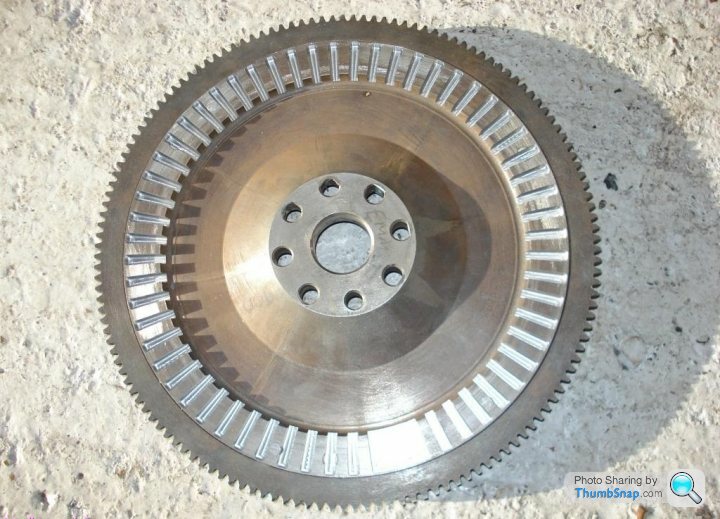
The question of whether or not it is worth doing and who to use. Yes... 100% worth it. You get a 'sparkle' from the engine which isn't there with traditional control systems. In terms of who to use... a good option is to see who your local rolling road recommend as you'll be going to them for the tuning so by picking something they recommend and are familiar with you are helping yourself a lot.
A fully sequential setup will save you a lot of fuel and allow for some fine tuning and is certainly the way to go but it does not significantly increase performance so isn't 100% necessary if it is going to be difficult to achieve in your setup.
A fully sequential setup will save you a lot of fuel and allow for some fine tuning and is certainly the way to go but it does not significantly increase performance so isn't 100% necessary if it is going to be difficult to achieve in your setup.
ingenieur said:
... a good option is to see who your local rolling road recommend as you'll be going to them for the tuning so by picking something they recommend and are familiar with you are helping yourself a lot.
Ironically, now that I know Emerald/Dave Walker are in Watton, that probably makes them as close as makes no difference to being my local rolling road....Which given their reputation makes it almost a no-brainer (unless they are vastly more expensive than the company I originally linked).
I pinged them an email earlier today - currently awaiting a response.
Edited by Equus on Saturday 30th September 07:38
//j17 said:
To be honest most 'carb and dizzy' EFi conversions run quite happily with grouped injection. No it isn't as efficient as sequential - but the faff of getting an accurate cam position signal on older classics just isn't worth the small extra benefit.
And for the uninitiated remember that the crank rotates 2 times for each full cycle of the engine, so from a crank position sensor (and for 'normal' engine configurations) you can tell which pair of cylinders are at TDC, just not which of the pair is on it's compression stroke/which on it's exhaust stroke - but critically in group/batch fired injection and ignition neither do you care, you just do both anyway.
For ignition this just means while one spark fires in a cylinder full of charge and gives you your 'bang' the other fires in a cylinder with nothing left to burn in it and with an open exhaust value. This is why it's also known as "wasted spark ignition", that second spark not doing anything.
For injection one injector fires and pumps some fuel into an inlet with an open inlet value, so it goes into the cyclinder as part of 'suck'. The second injector also files, but into an inlet with a closed value so just sits there while the engine cycles. At the technical level while that fuel is sat in the inlet track it's starts to drop out of being a fine mist from the injector and theoretically would all 'fall out' of the air and pool on in the tracked/on the back of the inlet value. In reality even ticking over at 1,000RPM you have 16 revolutions of the crank every second, so the time that 'blocked' injection has to drop out of the air is only something like 1/8th of a second so makes little practical difference.
Does that mean you have to base the mixture for each charge on the basis of there having been two injections of fuel for each firing cycle? And for the uninitiated remember that the crank rotates 2 times for each full cycle of the engine, so from a crank position sensor (and for 'normal' engine configurations) you can tell which pair of cylinders are at TDC, just not which of the pair is on it's compression stroke/which on it's exhaust stroke - but critically in group/batch fired injection and ignition neither do you care, you just do both anyway.
For ignition this just means while one spark fires in a cylinder full of charge and gives you your 'bang' the other fires in a cylinder with nothing left to burn in it and with an open exhaust value. This is why it's also known as "wasted spark ignition", that second spark not doing anything.
For injection one injector fires and pumps some fuel into an inlet with an open inlet value, so it goes into the cyclinder as part of 'suck'. The second injector also files, but into an inlet with a closed value so just sits there while the engine cycles. At the technical level while that fuel is sat in the inlet track it's starts to drop out of being a fine mist from the injector and theoretically would all 'fall out' of the air and pool on in the tracked/on the back of the inlet value. In reality even ticking over at 1,000RPM you have 16 revolutions of the crank every second, so the time that 'blocked' injection has to drop out of the air is only something like 1/8th of a second so makes little practical difference.
Yertis said:
Does that mean you have to base the mixture for each charge on the basis of there having been two injections of fuel for each firing cycle?
That would seem logical. An added note: injector duty cycles of 80% or more at peak power are not uncommon, which means the injector is spraying at a closed valve most of the time anyway.
Gassing Station | Classic Cars and Yesterday's Heroes | Top of Page | What's New | My Stuff



